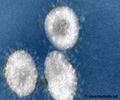Researchers have now come a step closer to understanding how to disable a part of SARS virus that helps it hide from the immune system, which may help them develop a vaccine against the disease

Because MERS and SARS are related, insight into one could provide a shortcut to finding a treatment or developing a vaccine for the other.
Mesecar and his team captured the molecular structure of a key SARS enzyme, papain-like protease, and revealed how it strips a host cell of the proteins ubiquitin and ISG15, which are involved in triggering an immune response.
He said with most viruses, when a cell is infected it sends out an alarm triggering an immune response that fights the infection, but successful viruses are able to trick the immune system.
Masecar said that by clipping off these two proteins, SARS short circuits the host cell's signaling pathways and prevents it from alerting the immune system to its presence and by removing these proteins, the enzyme serves as a biological cloaking system for the SARS virus that allows it to live and replicate undetected.
The disruption in its natural signaling pathways also causes an infected cell to miscommunicate with the cells around it, which leads to a response that eventually kills those cells, he said.
Advertisement
Source-ANI











